An Examination
by Brian Hioe
語言:
English /// 中文
Photo Credit: Brian Hioe
POLICE VIOLENCE was intimately tied up with the history of the Sunflower Movement from the beginning. The initial occupation by students on the night of March 18th, 2014 was resisted by police from the get-go. Did anyone, after all, expect police to simply step aside as students forced their way into the Legislative Yuan chambers? But it is as a result that police violence has also been a controversial issue, with some pointing towards the brutality of police, still others offering that police were only doing their jobs, and some pointing towards the illegality of police actions altogether.
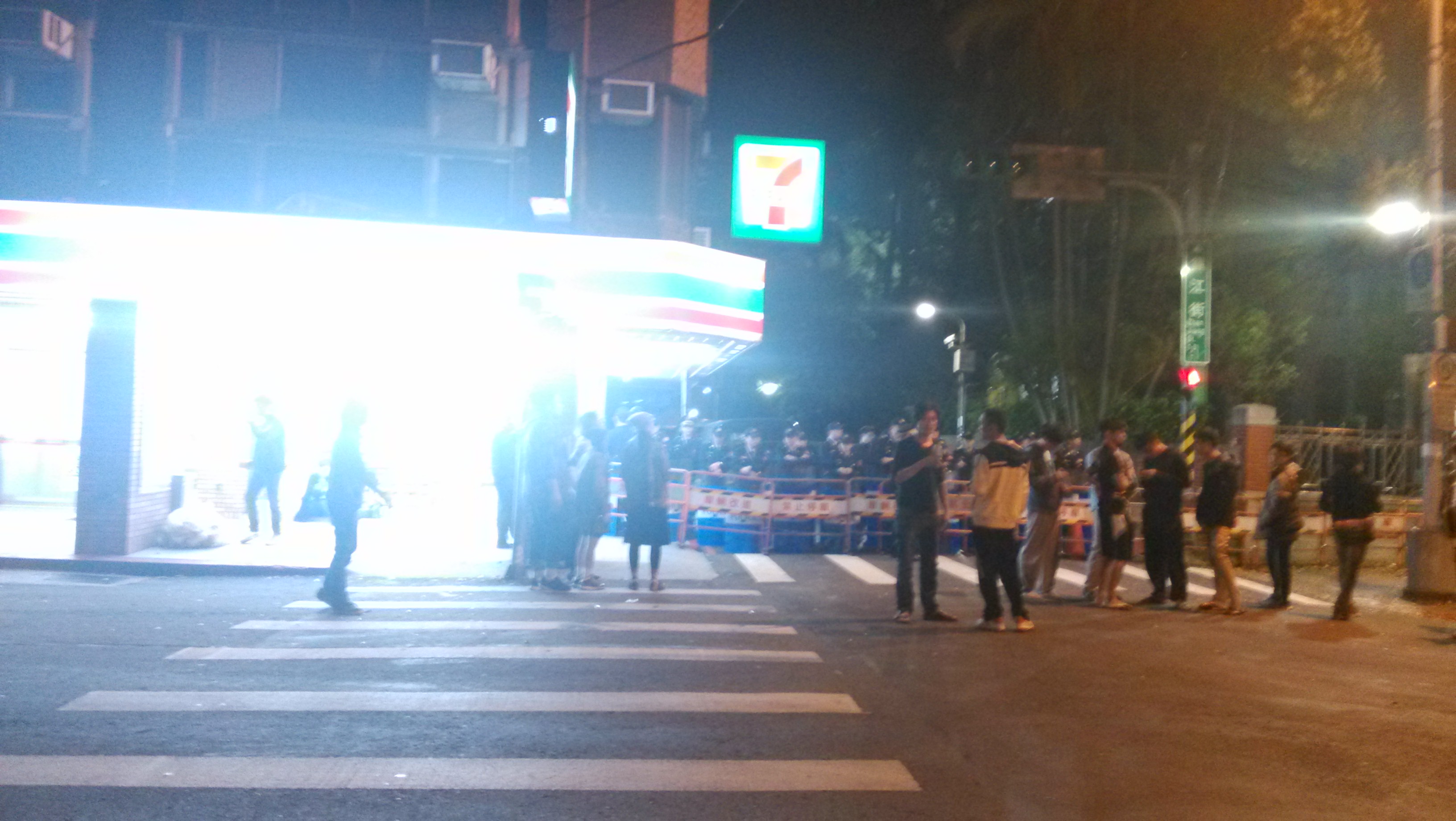 Police massed outside of the Seven-Eleven next to the Legislative Yuan on 318. Photo credit: Brian Hioe
Police massed outside of the Seven-Eleven next to the Legislative Yuan on 318. Photo credit: Brian Hioe
As some have offered, more often in arguments criticizing the actions of the police, it is probably true that the Sunflower Movement was the largest concerted use of police force in Taiwan since the end of the martial law. This is very probably true where the Sunflower Movement was quite simply the largest social movement since the end of Taiwan’s authoritarian period. So, questions of moral judgment aside, it should not be surprising that police force took place on a scale larger than had been seen in the past two decades. Nevertheless, we might conduct a narrative examination of police violence in the Sunflower Movement in the interests of providing a clearer picture of what exactly happened.
Actions by Police Against Legislative Yuan Occupiers
APART FROM the fact that police, of course, resisted the initial student incursion into the Legislative Yuan on 318 and were unable to fend off their entrance into the legislative chambers of the Legislative Yuan, police remained in control of the rest of the building for the duration of the occupation. This meant that students only controlled the legislative chambers in the Legislative Yuan building and did not have direct access to the outside world through the front, back, or side entrances of the Legislative Yuan.
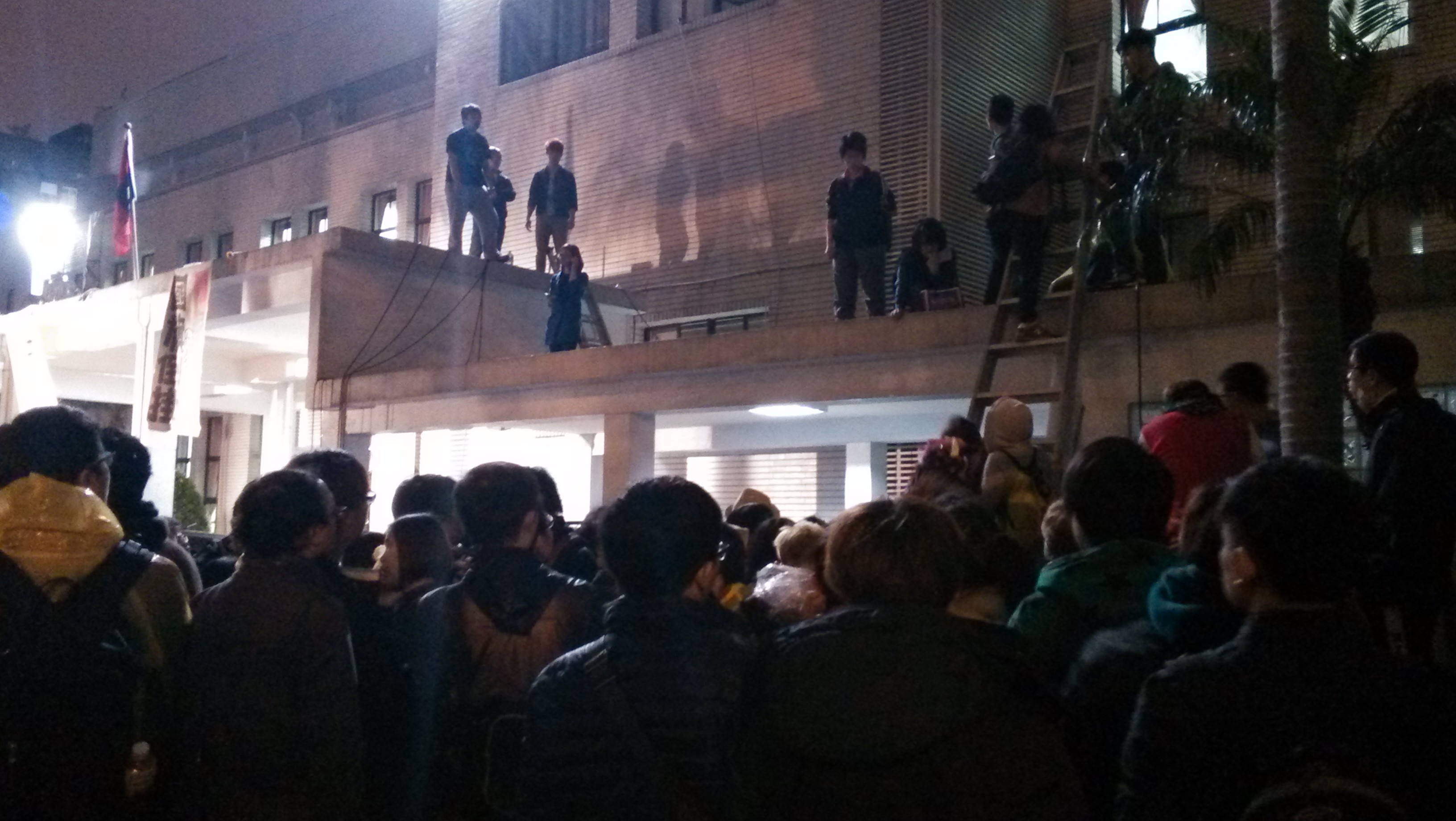 The ladder and roof onto which students entered or exited the Legislative Yuan and carried supplies back and forth. Photo credit: Brian Hioe
The ladder and roof onto which students entered or exited the Legislative Yuan and carried supplies back and forth. Photo credit: Brian Hioe
Students had to pass in and out of the Legislative Yuan through a ladder leading onto the roof and then entering through a window. This led to a situation where students would have to climb a ladder in order to precariously enter the Legislative Yuan and also ferry supplies in and out of the building through the Legislative Yuan. This, of course, would have been quite dangerous if anyone had fallen but, thankfully, this did not happen during the 23-day occupation. Where police actions placed students in danger for the duration of the occupation, it was through an unwillingness to allow students a safer means of entering or exiting the Legislative Yuan compound. But we might also place some blame with the public, where response to students breaking a Legislative Yuan window in order to transport supplies was extremely negative, and determined both police and student responses.
Police, particularly during the beginning of the occupation, took actions to make the lives of students as uncomfortable as possible. Air conditioning was turned off within the legislative chambers, only being restored later on after demands. Throughout the occupation, that Internet and other forms of communication between the legislative chambers and the outside world had weak signal was also sometimes thought to be the doing of police. Police also blocked access to restrooms early on before later being persuaded to withdraw; one can see the shades of puritanism from the Taiwanese public where in the absence of access to restrooms, students had to find other ways of relieving themselves, but there were some vicious responses from the public nonetheless. Yet convincing police to allow students access to restrooms required some action by the crowd which had gathered outside the Legislative Yuan and then forced itself into the Legislative Yuan courtyard on the night of March 18th through protest chants demanding that students be allowed access to the restroom.
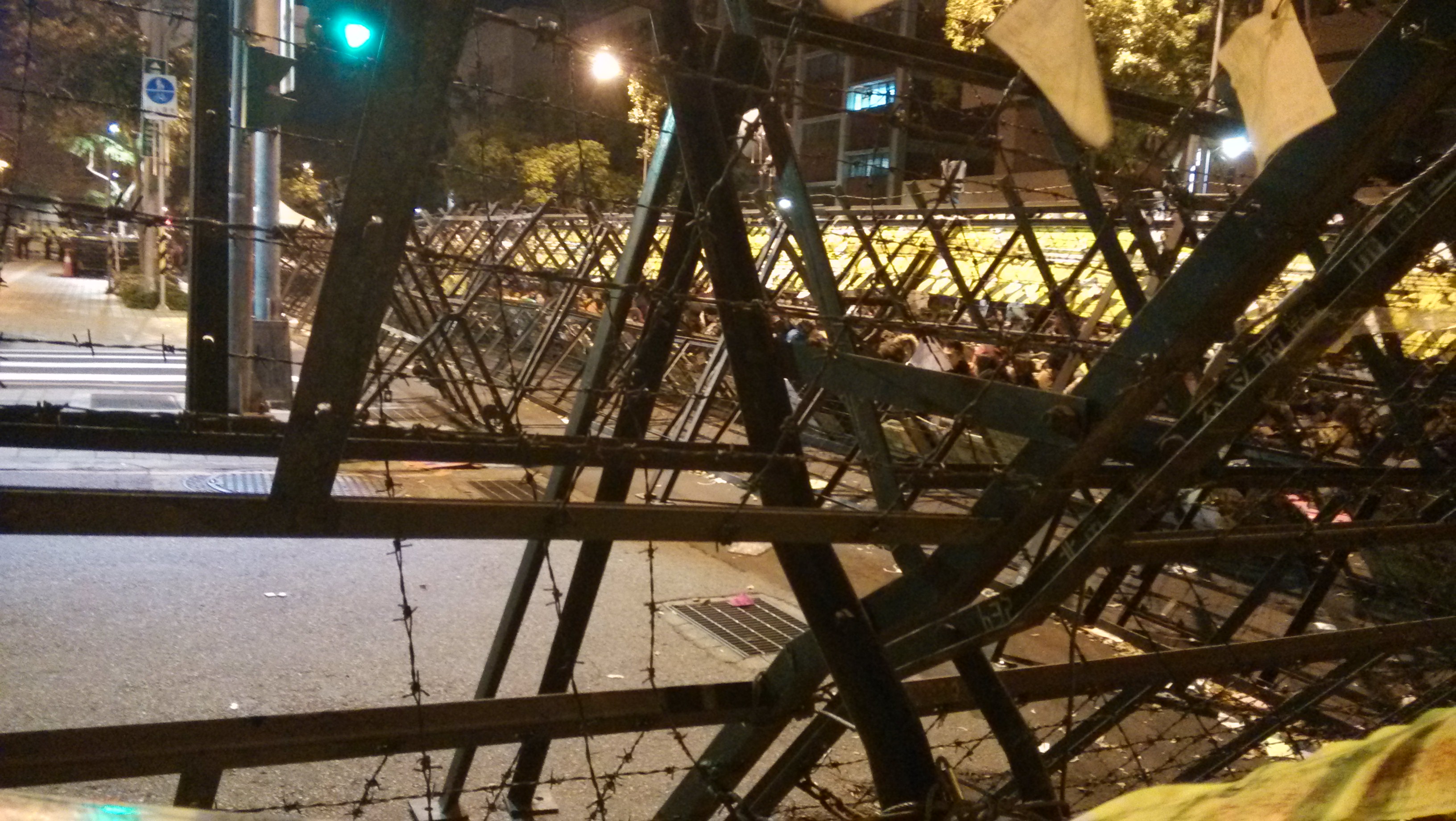 Police barriers on March 22nd. Photo credit: Brian Hioe
Police barriers on March 22nd. Photo credit: Brian Hioe
This became ridiculous at times. Indeed, I recall thinking to myself then that I would probably never be in a protest situation ever again where I would wind up in the courtyard of a national legislature in the dead of night, demanding with a crowd of thousands that a group of several hundred students be allowed access to…a restroom.
Between 318 and 324
WHILE POLICE resisted the initial occupation incursion, attempts made by the crowd to drive police back from the front and side entrances during the initial night of March 18th were not successful. Crowds were successful in pushing police back from an alleyway between the Legislative Yuan and a neighboring Seven-Eleven, and though police took this alleyway again by morning, they later permanently withdrew, leaving the alleyway open to protestors for the duration of the Legislative Yuan occupation. It is true that some police themselves suffered injuries, though the most threatening case of this was not a case of physical injury, but when a member of the riot police suffered an asthma attack and had to be carried out of the courtyard.
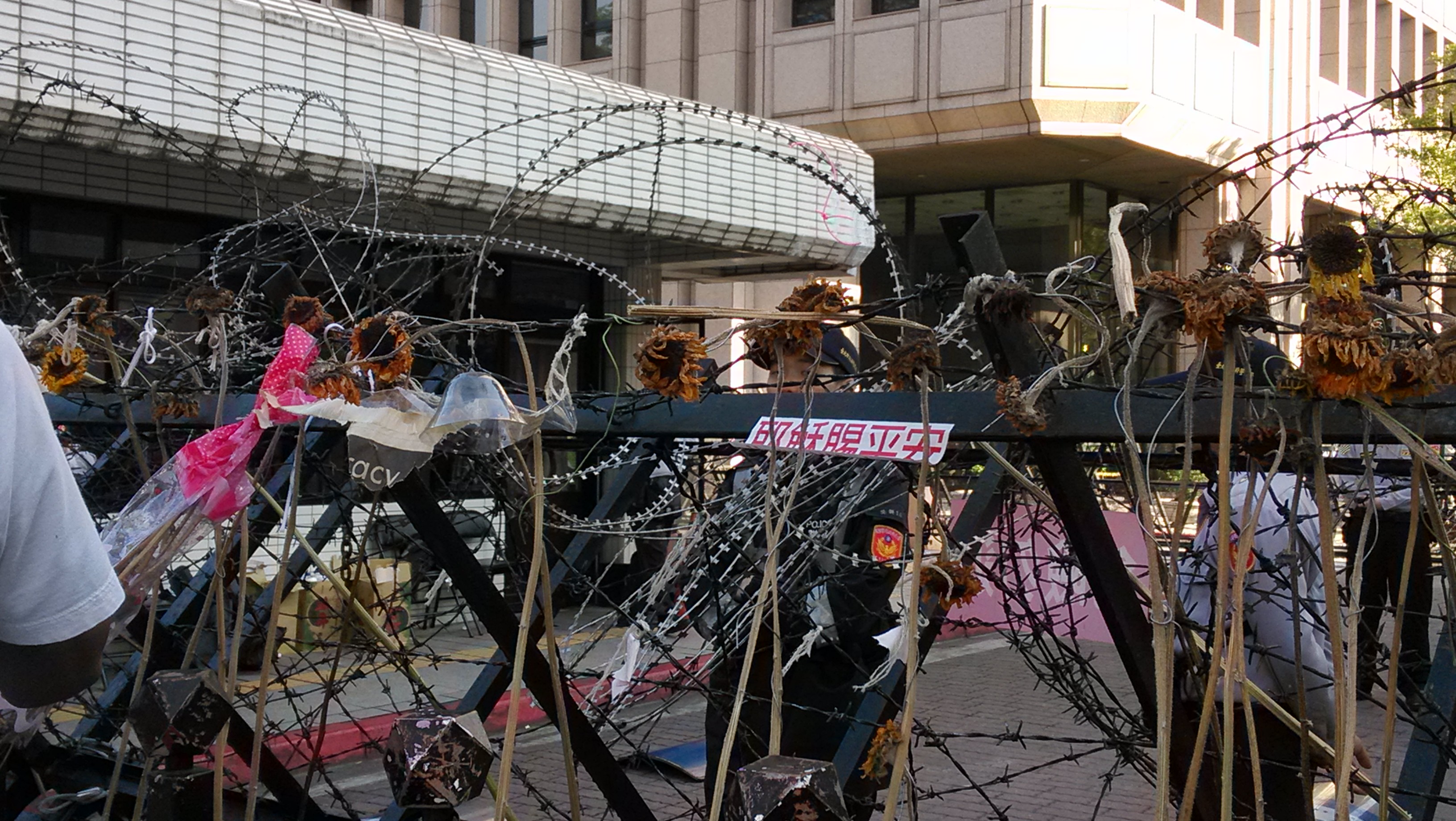 Razor-sharp wire barriers deployed by police. Photo credit: Brian Hioe
Razor-sharp wire barriers deployed by police. Photo credit: Brian Hioe
Violent interactions with police were minimal in the period between 318 and 324 when large crowds began to gather nightly around the Legislative Yuan. More controversial, however, were the razor-sharp wire barriers set up by police around the Legislative Yuan in order to block off access. So controversial were these barriers, with pictures circulated on the Internet, that they were later withdrawn, to be replaced by less menacing-looking, and less obviously physically threatening barriers. This type of barriers was only used minimally after the public backlash that came from their original deployment.
It was, of course, 324 which would foreground police violence for the rest of the movement. The police reaction against the group of protestors that sought to break into the Executive Yuan, Taiwan’s executive branch of government, on the night March 23rd was probably the height of police violence during the movement. Use of force to drive out protestors, including beatings with batons, was evidenced in the widely circulated photos of bleeding individuals. Though less publicized, there were also incidents in which barriers closed upon protestors, crushing them. But most dramatically the night saw the first firing of water cannons during the Sunflower Movement, one of the few uses of water cannons since the end of Martial Law in Taiwan.
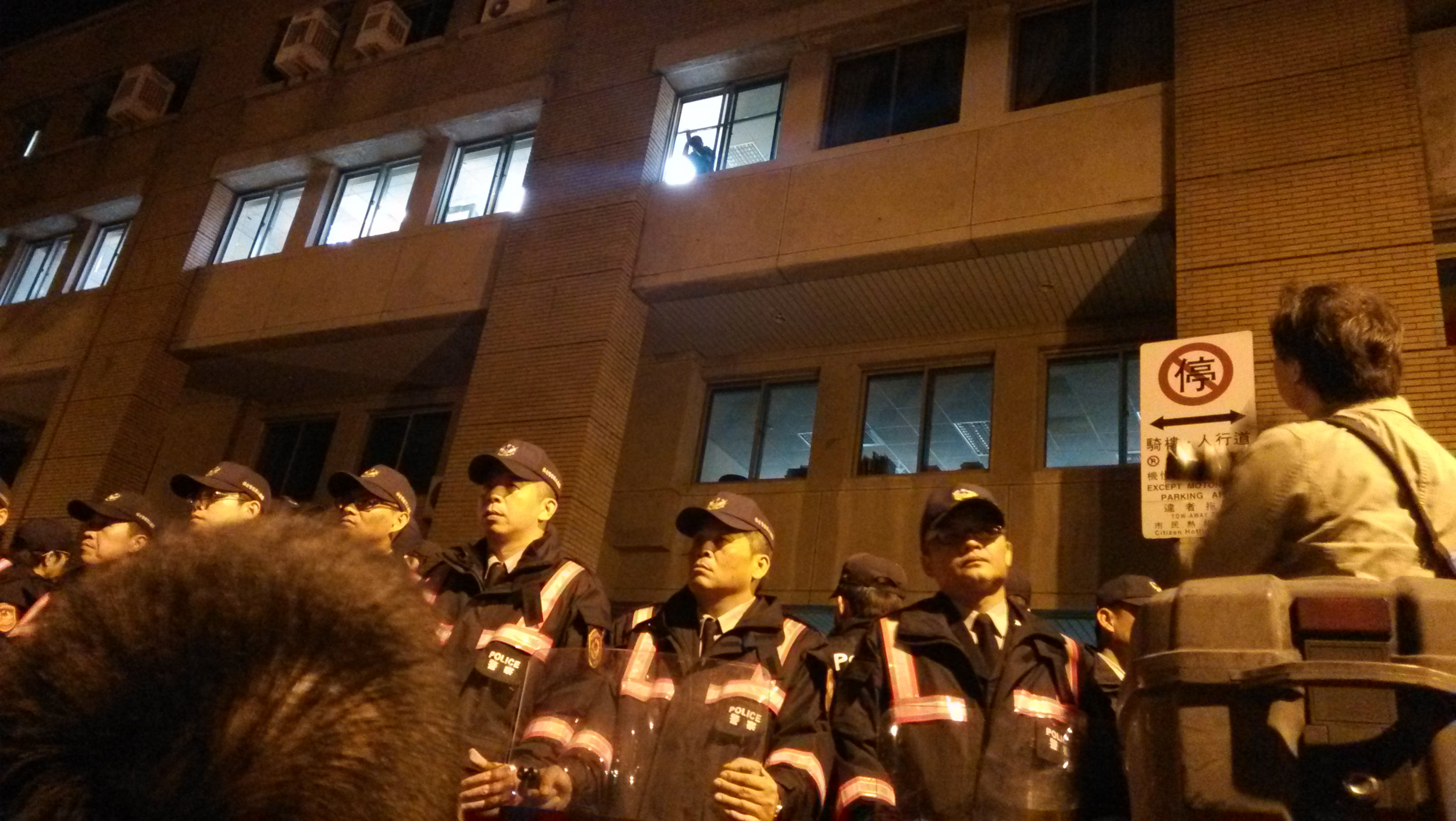 Confrontation with police during the night of the attempted Executive Yuan occupation. Visible in the window is a student occupier in the Executive Yuan. Photo credit: Brian Hioe
Confrontation with police during the night of the attempted Executive Yuan occupation. Visible in the window is a student occupier in the Executive Yuan. Photo credit: Brian Hioe
It is true that there were, in fact, several hours that passed between the initial occupation attempt of the Executive Yuan attempt on the night of March 23rd and when police began to use force to drive protestors outside of the courtyard of the Executive Yuan which had been breached in the early morning hours of March 24th. But this incident would later lead eight protestors to file charges of attempted murder against President Ma Ying-jeou, former premier Jiang Yi-huah, and National Police Agency Director-General Wang Cho-chiun. In particular, Jiang Yi-huah, who was viewed as responsible by ordering the crackdown, was singled out to blame for the violence. These cases were later dismissed in December, to the criticism of well-known lawyer Wellington Koo and the Judicial Law Foundation, who accused the state of abetting police violence. Questions of the legality of the police violence used on the night of have yet to be settled, arguments about the legality or illegality of violence largely dividing along politically partisan lines.
From the White Wolf to Taking a Stand
THE LARGE SCALE rally that took place on March 30th, 2014—“330”—largely went without violent incident, considering that 500,000 descended upon Taipei that day for a protest that had been called three days before by Legislative Yuan occupiers. Police were certainly present, but largely a subdued force. Yet it would be two days later that questions of police violence culpability or complicity in violence would be foregrounded yet again, with the occasion of gangster “White Wolf” Chang An-Lo’s visit to the Legislative Yuan, promising to violently evict protestors.
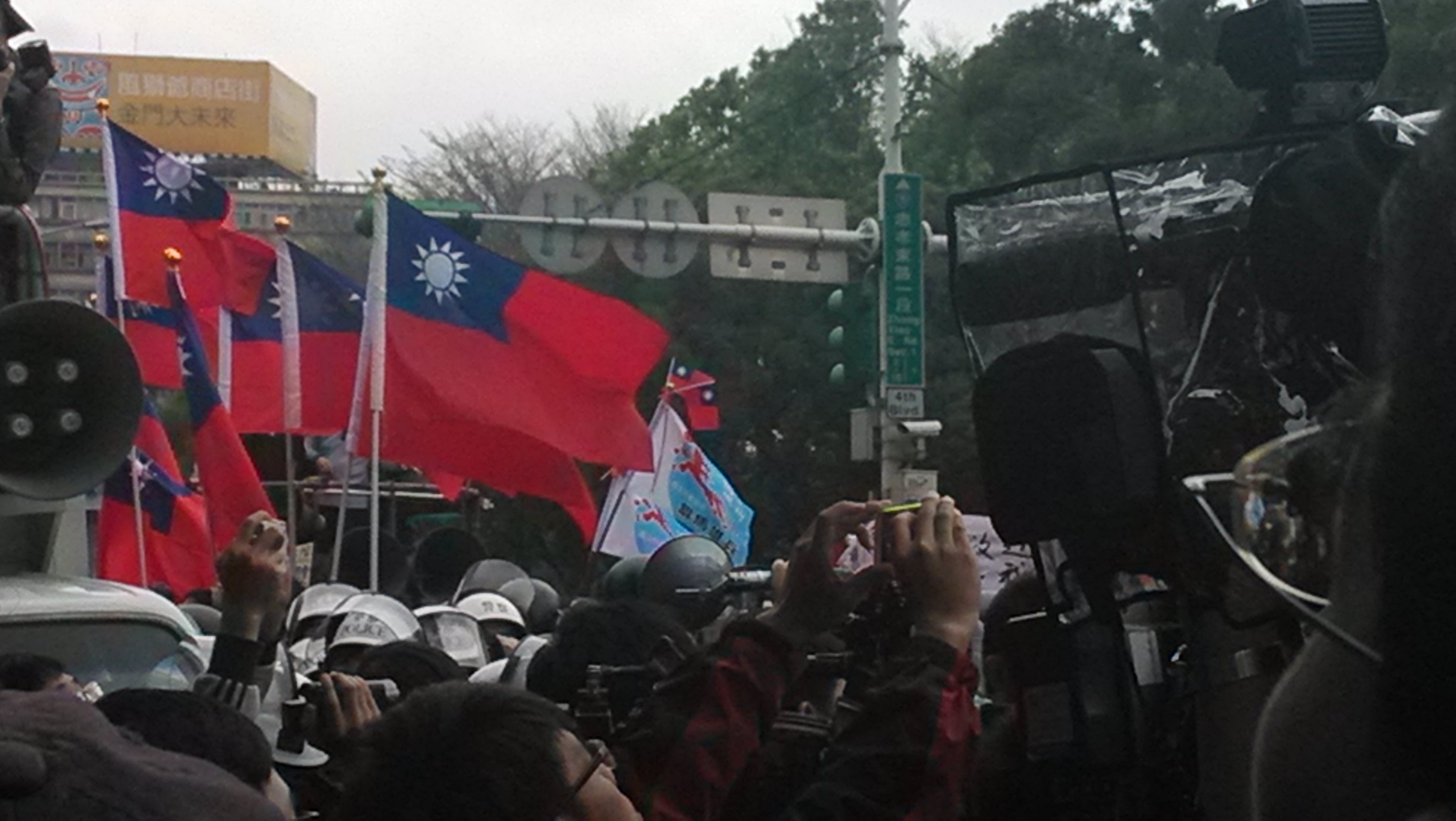 Chang An-Lo and supporters on April 1st. Photo credit: Brian Hioe
Chang An-Lo and supporters on April 1st. Photo credit: Brian Hioe
Chang, former leader of the Bamboo Union organized crime group, the largest of Taiwan’s triads, and current leader of the pro-unification China Unification Promotion Party, rose to fame in the 1980s for the assassination of Taiwanese journalist Henry Liu at the behest of Chiang Ching-Kuo. In what was probably a publicity move, Chang had vowed to violently evict students from the Legislative Yuan, and on April 1st, he arrived the Legislative Yuan encampment with several hundred of his subordinates, likely gangsters, in tow. Though no promised eviction took place and the occasion was largely devoted to speechifying by Chang and China Unification Promotion Party members on a platform set up on Zhongxiao West Road, Chang’s lackeys devoted much of their energy to attempting to provoke nearby protestors into physical altercations. Though this was largely unsuccessful, protestors who did, in fact, stray too close were beaten.
Police did not intervene in any real capacity in this incident, where a large number of police were on stand by during the event, and a large number of police amassed outside of the National Police Agency to prevent possible invasion. Evaluations of the police ran from praising their restraint to criticizing their inaction to prevent attacks on protestors.
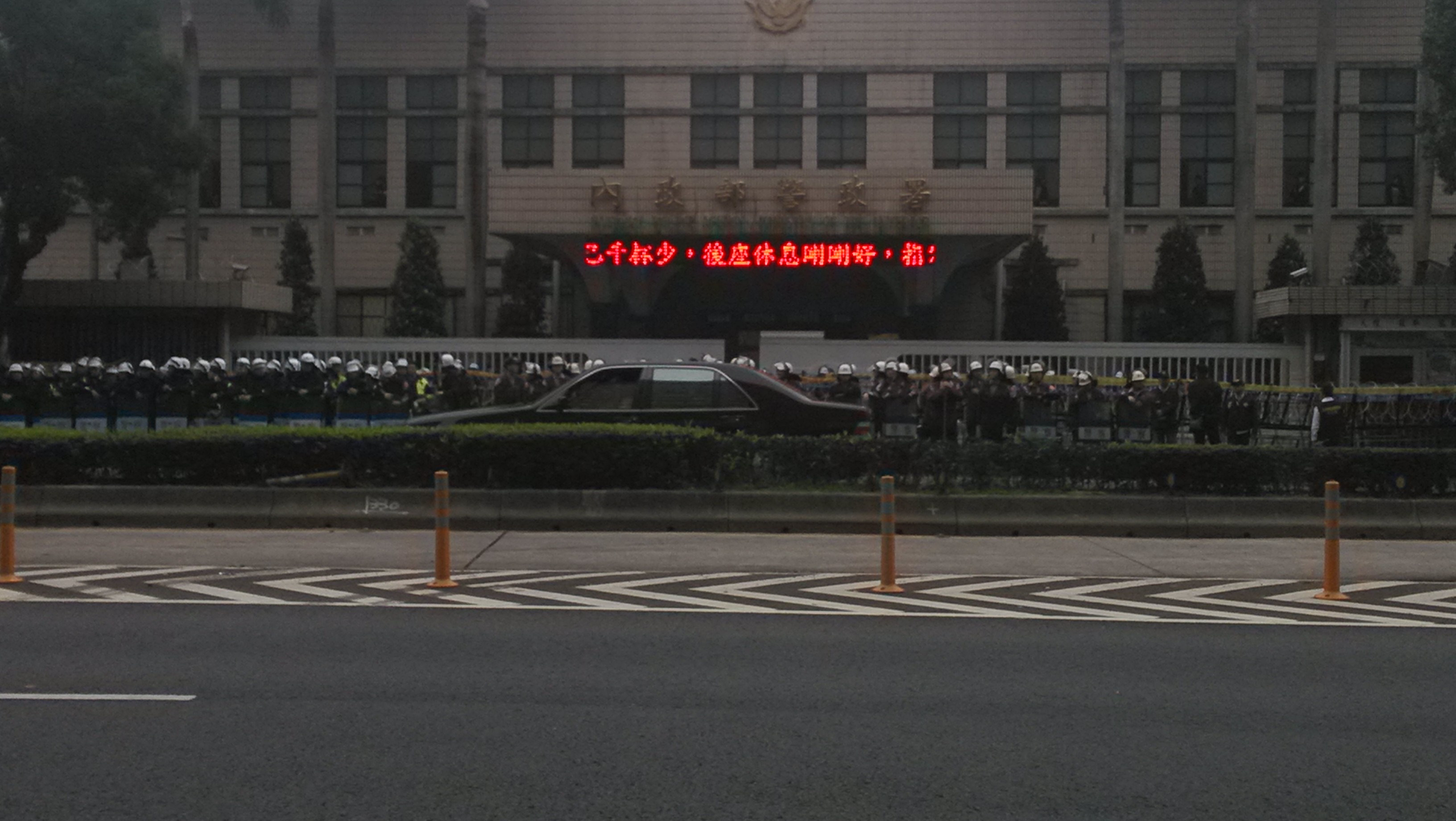 Police massed outside of the National Police Agency. Photo credit: Brian Hioe
Police massed outside of the National Police Agency. Photo credit: Brian Hioe
Occasional flare-ups aside, the next ten days were largely placid in terms of police action until the withdrawal of students from the Legislative Yuan on April 10th. Where some students refused to withdraw, however, police force was used, particularly against members of the Alliance of Referendum for Taiwan who refused to leave and stayed in the courtyard in front of the Legislative Yuan, before police drove them out close at 6:40 AM of the following morning, this despite a promise made by police chief Fang Yang-ning, Chief of Zhongzheng First Police Precinct at 2:30 AM that police would not be violently driving out protestors. During the tumult that followed, Tsay Ting-Kuei, the convenor of the Alliance of Referendum for Taiwan, was struck by a scooter after running into traffic.
As a result, close to 1,000 people would gather outside of Zhongzheng First Police Precinct that night, surrounding the police station and refusing to allow police leave. It was only after Fang Yang-ning came out and announced that he would be resigning that crowds dispersed. While many were condemnatory of police, still others rallied towards police, Taipei Mayor Hau Lung-bin offering his support of Fang and stating that he would not ask Fang to resign, as he had done nothing wrong, and a Facebook page created in support of Fang racking up 180,000 Likes.
Support of Fang developed out of the thematic of critics of the Sunflower Movement criticizing protestors for opposing police who were, after all, public servants and guardians of public order. What was seized upon was not only the conflicts which had broken out between protestors and police, protestors being painted as antisocial elements, but also how police had lives of their own and families to take care of, yet were being needlessly forced to work overtime because of protests. Thus, this oftentimes involved the discourse of family, with wives and children of police officers speaking out against protestors for disrupting their family harmony, with the broader implication that through disrupting the family harmony of police officers and their families, they were disrupting social harmony itself.
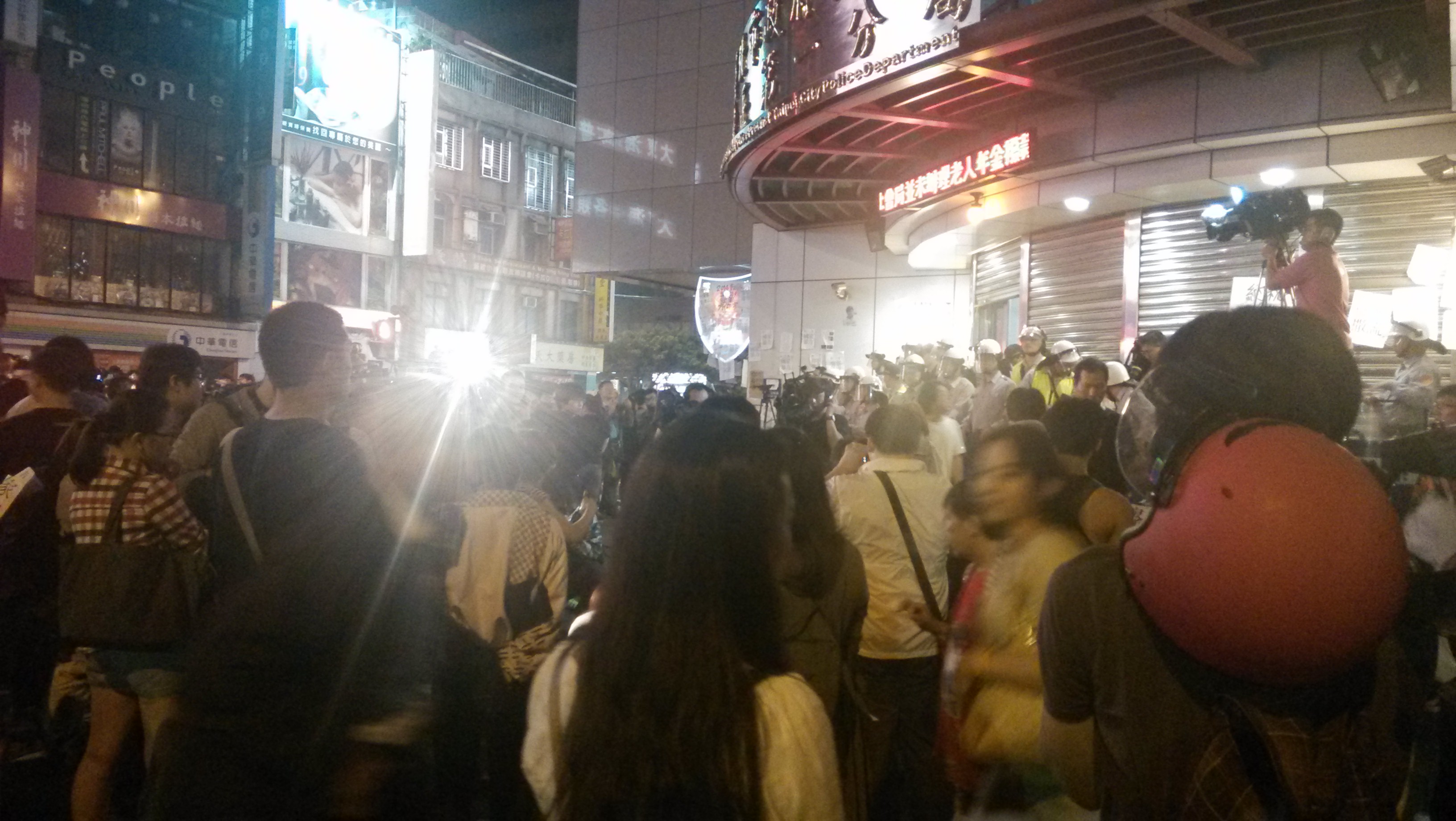 Protestors surrounding Zhongzheng First Police Precinct on the night of April 11th. Photo credit: Brian Hioe
Protestors surrounding Zhongzheng First Police Precinct on the night of April 11th. Photo credit: Brian Hioe
At other points, within the Sunflower Movement itself, some protestors who were themselves relatives of police would speak out in criticism of these kind of smear attempts in the name of police families, though they sometimes evidenced mixed feelings in doing so. Some police themselves followed, though in this, they often had to conceal their identity. In particular, if memory serves correctly, around this time, a supposed police officer who was most likely a riot squad member began making appearances at protests while wearing riot gear that had been covered with stickers in support of the Sunflower Movement, though keeping his face concealed. This was so to express support of protestors, but also because of his apparent need to conceal his identity because of his job.
Conflict with Police During the Resurgent Anti-Nuclear Movement
WHILE THE withdrawal of students from the Legislative Yuan marked the end of the Sunflower Movement proper, action continued on into weeks after during Lin Yi-Hsiung’s hunger strike against nuclear power. Lin’s hunger strike, which lasted from April 22nd to April 30th, served to channel much of the energy of the Sunflower Movement into the anti-nuclear movement during a period of fragmentation following withdrawal from the Legislative Yuan. But it may have actually been during this period of time that tensions between protestors and police ran highest.
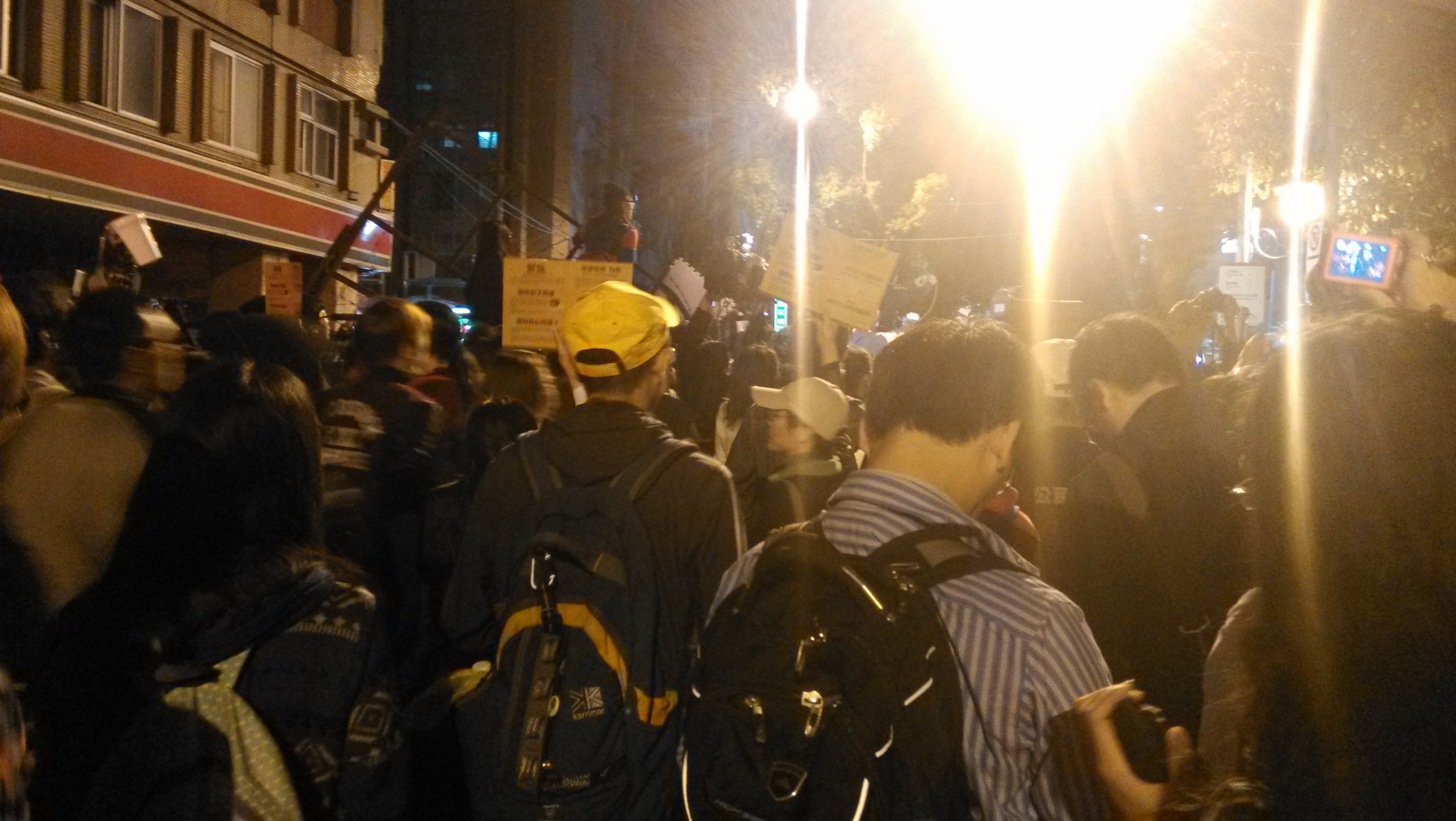 Demonstrators outside the Legislative Yuan encampment on April 22nd. A police barrier dismantled by protestors can be seen in the background. Photo credit: Brian Hioe
Demonstrators outside the Legislative Yuan encampment on April 22nd. A police barrier dismantled by protestors can be seen in the background. Photo credit: Brian Hioe
The nearly forgotten incident on April 22nd, the day Lin’s hunger strike started, is worth relating. This was hardly reported on in the news; I only witnessed this because I happened to be passing by the area. An attempt by some protestors who had amassed around the former Legislative Yuan encampment to force there way through barriers led to a stand-off with police. Namely, a group of several hundred individuals had gathered around the Legislative Yuan site to mark the start of Lin’s hunger strike and several individuals attempted to climb the barbed wire barriers which still remained surrounding the Legislative Yuan.
After these individuals became injured from falling off the barriers, they were arrested by police and refused access to ambulances or lawyers, leading to a standoff which lasted well over an hour, I recall close to two hours. Though police were eventually persuaded to allow a lawyer who happened to be on-site in, they were more hesitant to allow ambulances through where they might require dismantling barriers. The crowd in fact became agitated enough that it began dismantling some barriers during this time and was successful in dismantling at least one segment of the barrier surrounding the Legislative Yuan, but eventually the situation was diffused when police acquiesced to allowing ambulances through. There seem to have been several such incidents during Lin’s hunger strike, as daily protests both in Daan Park and outside the Legislative Yuan were happening during this time, but tensions may have ran highest during the first day of Lin’s hunger strike.
But the large scale occupation of Zhongxiao West Road of 50,000 individuals on April 27th became another occasion for police violence. This followed the pattern of the student withdrawal which had happened on April 10th, in that while the “occupation” became a one-day demonstration for most individuals, those who were in fact willing to occupy and intended to remain at night were driven out by police in early morning hours. Once again, this involved the firing of water cannons, but for whatever reason, this did not become as intensely politically charged a matter as 324—likely because of the controversy surrounding the attempt to occupy the Executive Yuan to begin with. This was the last major incident of the extended “Sunflower Movement,” if we are to include the period of the resurgent anti-nuclear movement after the withdrawal from the Legislative Yuan within the rubric of a broader “Sunflower Movement”.
Conclusion
CERTAINLY THERE have been other incidents of police use of force since the end of the Sunflower Movement. For example, the eviction of occupiers outside the former Songshan Tobacco Plant, to protest the illegal cutting down of trees to build Taipei Dome. And the use of police force to disperse protestors in Taiwan is not uncommon. But in examination of the past history of police violence during the Sunflower Movement, we can draw certain conclusions about how the police conducted themselves.
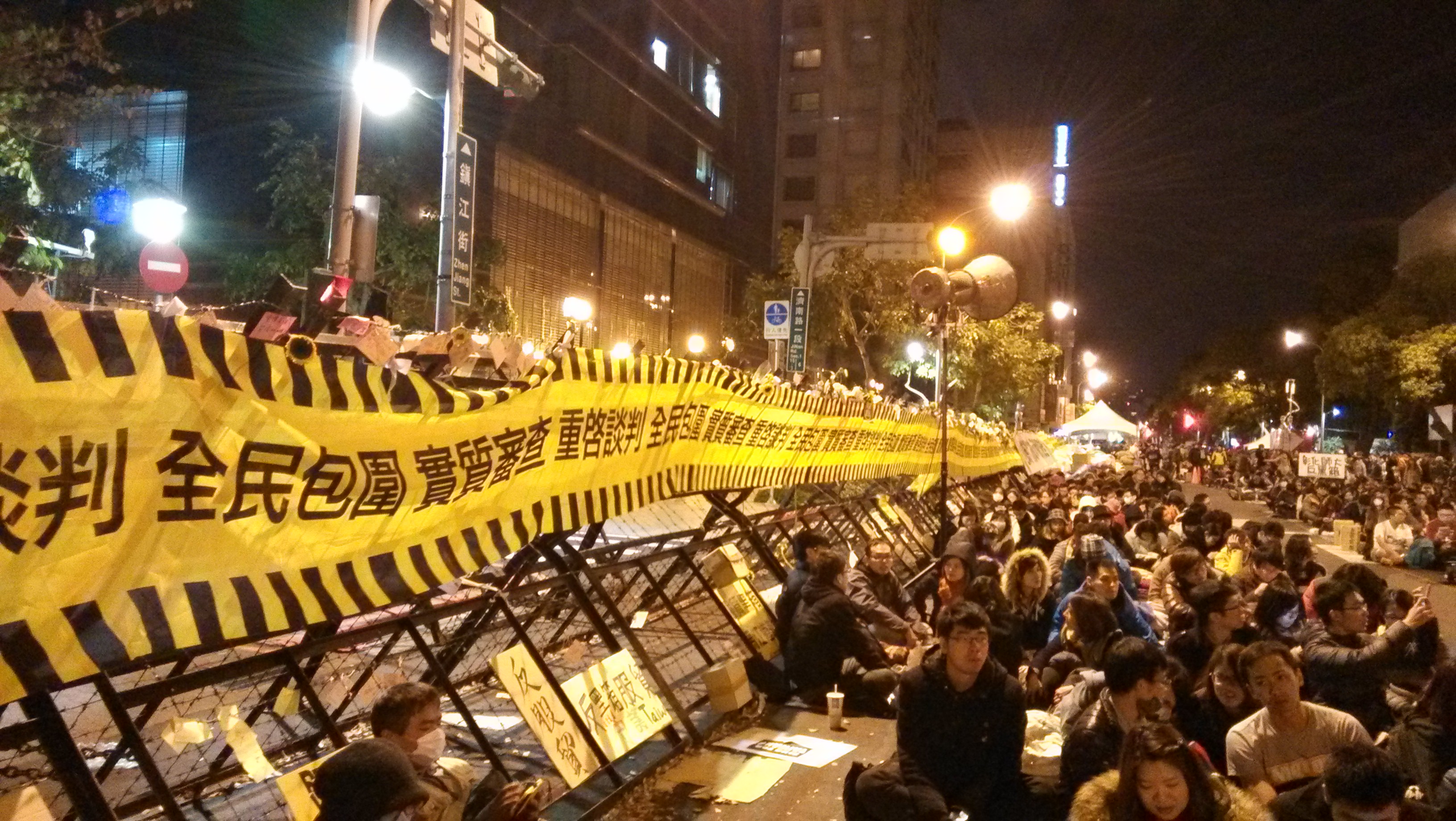 Police barriers outside the Legislative Yuan encampment on March 22nd. Photo credit: Brian Hioe
Police barriers outside the Legislative Yuan encampment on March 22nd. Photo credit: Brian Hioe
Debate about whether police were only “doing their jobs,” or variously justified in the use of force may in fact miss the point. Present times have spotlighted the circumstances in which police use of force has grown grotesquely out of hand, particularly in cases concerning systematic racism by police against blacks in the US. But is it not that the institution of the police is that institution whose use of violence is sanctioned for the sake maintaining what is deemed by the State to be legitimate public order? It is such that the police serve as guardians of public order—through that they have the legal right to exert violence in order to maintain public order. As such, debates about whether police are right or wrong, or merely doing their jobs or not miss the point, where the larger problem may, in fact, originate in the institution of policing where the police is inherently an institution of the State. It is not particularly surprising that the police, as an institution of the State, can act as its agents of repression. And in Taiwan, police can at least be reliably counted upon to act as an institution of the State, where elsewhere, police has taken the power to decide into their own hands and out of the hands of civilians in threatening fashion—as though it alone as the right to decide what public safety means.
For example, response to occasions of police violence, it is such in Taiwan that the call of civil society then becomes to call for a police union, in order that police can have some leeway against the demands of their government superiors when demanded to conduct attacks on the public. By contrast, in America, it is precisely police unions that become the agents of the out of control, unchecked means by which police take authority into their own hands as the legitimators of public order, even going against their civilian superiors—as the recent actions of New York City police unions against New York City’s Mayor DeBlasio when perceiving themselves as under attack from DeBlasio, during a time in which the NYPD was being criticized for systematic racism in several high profile shooting incidents, and came to feel the mayor was also targeting it after he expressed vague sympathy for protestors. At that point in time, the police unions declared that it was that they had become a “wartime police department”, much as a declaration of martial law might go, and took authority into its own hands in systematically refusing to enforce any laws except for life threatening crimes as, say, murder or shootings, as an act of protest against the mayor.
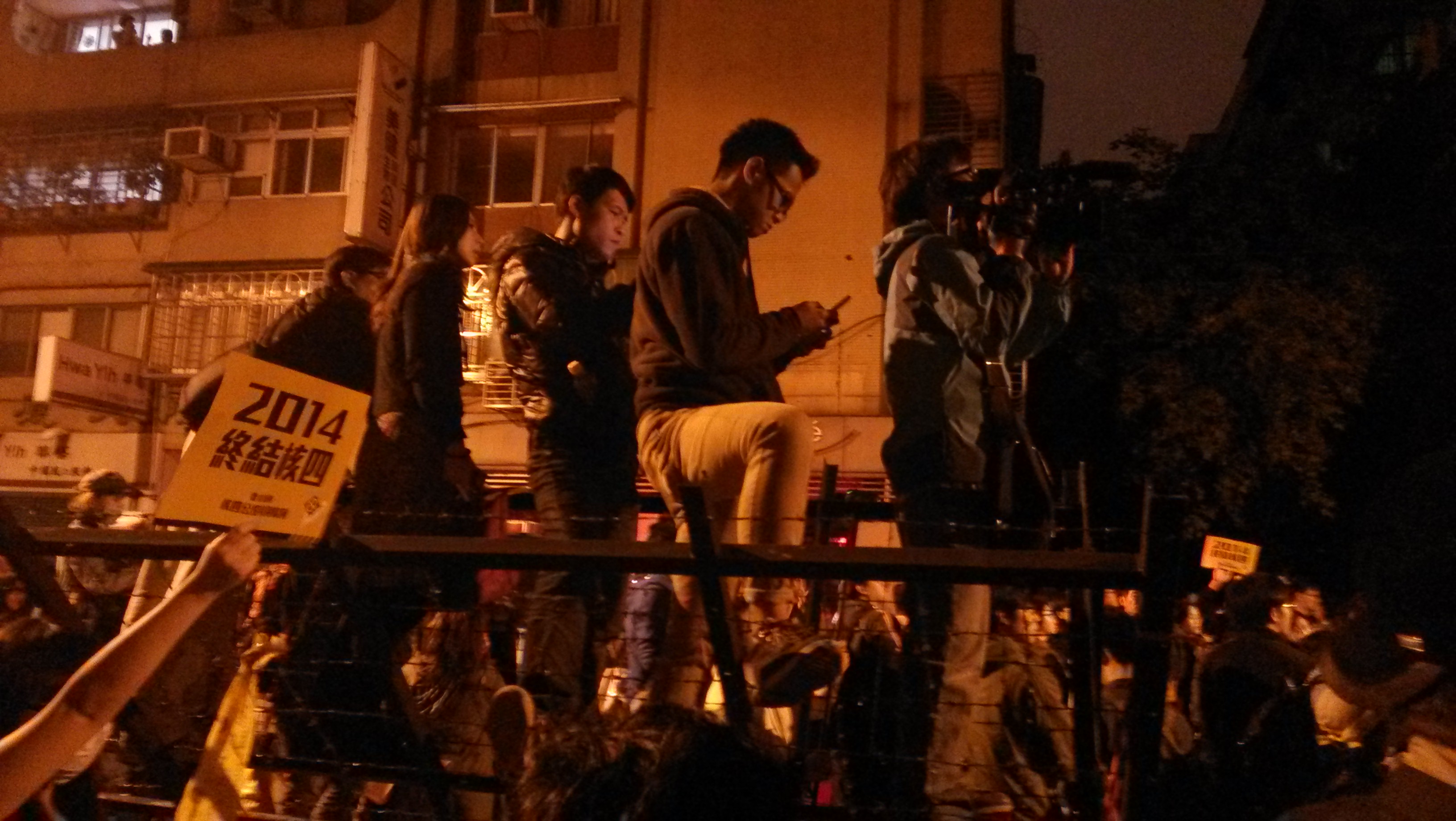 Demonstrator standing on a dismantled police barrier on April 22nd. Photo credit: Brian Hioe
Demonstrator standing on a dismantled police barrier on April 22nd. Photo credit: Brian Hioe
And, in fact, we might also raise the point that the culture of police violence in Taiwan is not actually as brutal as in America or other countries. Nobody was shot and killed during the Sunflower Movement, even when students sought to invade Taiwan’s executive branch of government. Even if there is a history of occupations of state legislatures in the United States, I suspect that if several hundred students had tried to invade the White House as an act of protest, say, in opposition to the Iraq War, they could have been fired upon. That was never a possibility in Taiwan. That’s just where Taiwanese society’s attitude towards violence differs from that of America, or it may be that is where structural violence is not as much a problem with Taiwanese police. And, for their part, Taiwanese sought to avoid relentless antagonism of the police during the Sunflower Movement in seeking to build bridges with police, even as the call in America for the past year has often been “Fuck the police” in the face of police who can kill at will and get away with it. It might just be that Taiwan is fortunate, where police behavior is concerned.
Yet some have raised international comparisons in order to dismiss claims that police need to be called accountable for their actions during the Sunflower Movement, citing that Taiwanese shouldn’t be complaining about their police when people in the rest of the world have it so much worse and that Taiwanese should just be appreciative of their police instead. On the other hand, we might point to how the police precisely should be called out on both in regards to the actions they took on behalf of their superiors and where they themselves might have been out of hand. Whether or not the verdict of history points to police brutality during the Sunflower Movement or not, this history needs to be examined carefully, with a critical eye as to the actions of police.
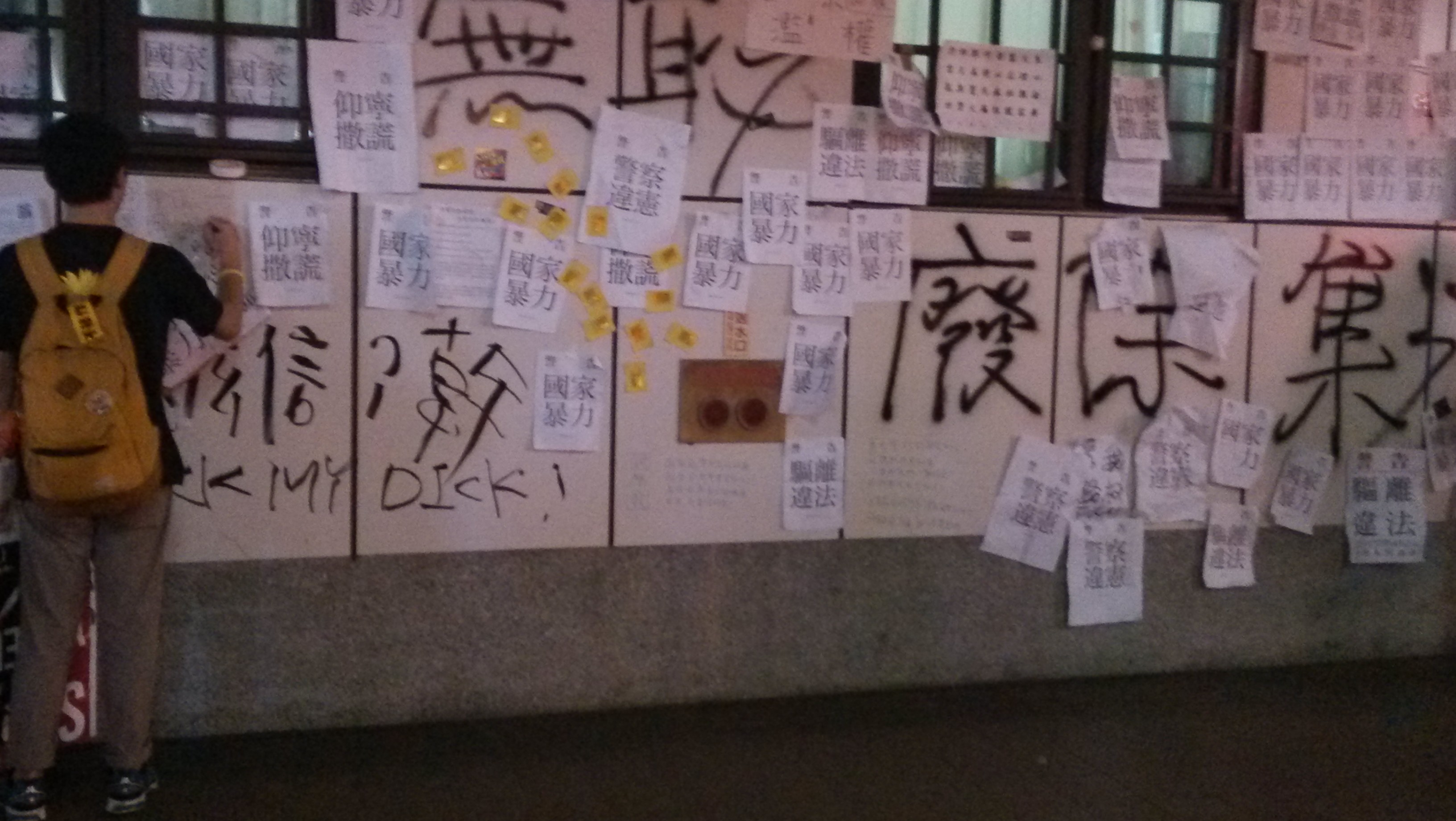 Graffiti on the wall of Zhongzheng First Police Precinct on the night of April 11th. Photo credit: Brian Hioe
Graffiti on the wall of Zhongzheng First Police Precinct on the night of April 11th. Photo credit: Brian Hioe
The point is that, as should be elsewhere, police in Taiwan need to be called to account for their actions. The institution of the police is the sole institution in society permitted the right to legal violence and so it demands special oversight, whether in Taiwan or elsewhere. The police, as an institution, too easily runs out of hand given this right to violence which is its raison d’être, and this lies in the structural constitution of the police as the enforcer of public order in society.
Where does justice lie? The aspiration towards justice was certainly one of the values the Sunflower Movement espoused, particularly in frequent claims by students that their actions were motivated by a sense of right and wrong—a sense of justice. As with all things, the record needs to be set straight if justice is to be achieved. And with police violence, as with the many other issues dating back to the Sunflower Movement which are unresolved, we shall see as to whether justice is achieved or not.













